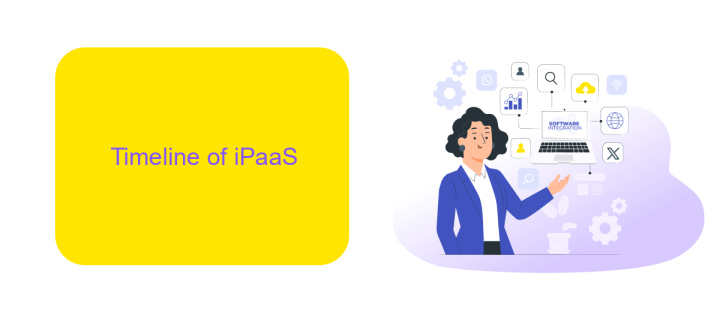iPaaS History
The history of Integration Platform as a Service (iPaaS) traces the evolution of cloud-based integration solutions designed to streamline and simplify data and application connectivity. Emerging in the early 2010s, iPaaS has transformed how businesses manage integrations, offering scalable, flexible, and cost-effective alternatives to traditional middleware. This article explores the key milestones and technological advancements that have shaped the iPaaS landscape.
Introduction
Integration Platform as a Service (iPaaS) has revolutionized the way businesses manage and integrate their various applications and data sources. Emerging in response to the growing complexity of IT environments, iPaaS offers a streamlined solution for connecting disparate systems, enabling seamless data flow and operational efficiency.
- Automated workflows
- Real-time data synchronization
- Scalable and flexible integration options
- Enhanced security and compliance
Services like ApiX-Drive have become essential in this landscape, providing user-friendly platforms that simplify the integration process. By offering pre-built connectors and an intuitive interface, ApiX-Drive allows businesses to quickly set up and manage integrations without the need for extensive coding knowledge. This democratization of integration capabilities has empowered organizations to innovate faster and respond more agilely to market demands.
Timeline of iPaaS

The history of iPaaS (Integration Platform as a Service) can be traced back to the early 2000s when businesses began to realize the need for seamless integration between various software applications. Initially, integration was achieved through on-premises middleware solutions, which were complex and costly. However, with the advent of cloud computing, the landscape began to shift towards more flexible and scalable solutions. By the late 2000s, the first iPaaS solutions emerged, offering businesses the ability to integrate cloud-based applications with on-premises systems in a more efficient manner.
As the demand for integration solutions grew, so did the capabilities of iPaaS platforms. In the 2010s, iPaaS providers began to offer more advanced features such as real-time data processing, API management, and pre-built connectors for popular applications. One notable example is ApiX-Drive, which simplifies the process of connecting different software systems without requiring extensive technical knowledge. Today, iPaaS continues to evolve, incorporating AI and machine learning to provide even more intelligent and automated integration solutions, making it an indispensable tool for modern businesses.
Key Players and Innovations

In the ever-evolving landscape of Integration Platform as a Service (iPaaS), several key players have emerged, driving innovation and shaping the industry. These companies have not only provided robust platforms but have also introduced groundbreaking features that simplify integration processes for businesses of all sizes.
- MuleSoft: Known for its Anypoint Platform, MuleSoft offers a comprehensive suite of tools for API management, integration, and analytics.
- Zapier: Specializes in automating workflows by connecting various apps and services, making it easier for non-technical users to set up integrations.
- ApiX-Drive: Focuses on enabling seamless integration between different services and applications, offering user-friendly interfaces and pre-built connectors.
- Workato: Combines enterprise-grade integration with automation, catering to both IT and business users.
- Informatica: Provides a robust iPaaS solution with advanced data integration capabilities and extensive cloud support.
These key players have introduced several innovations, such as low-code/no-code platforms, real-time data processing, and AI-driven automation. ApiX-Drive, for instance, has made significant strides in offering easy-to-use integration solutions, making it accessible for businesses without extensive technical expertise. As the iPaaS market continues to grow, these companies will likely lead the way in developing more advanced and user-friendly integration tools.
Market Evolution and Trends

The iPaaS market has experienced significant growth and transformation over the past decade. Initially, businesses relied on custom-coded solutions to integrate various applications, which was both time-consuming and resource-intensive. With the advent of iPaaS, companies began to adopt more scalable and efficient integration methods.
As the demand for seamless connectivity between cloud applications and on-premises systems increased, iPaaS solutions evolved to offer more advanced features. These platforms now provide robust data integration, real-time analytics, and enhanced security measures, making them indispensable for modern enterprises.
- Increased adoption of cloud-based solutions
- Greater emphasis on data security and compliance
- Integration with AI and machine learning technologies
- Enhanced user experience with low-code/no-code platforms
One notable trend is the rise of user-friendly iPaaS platforms like ApiX-Drive, which allow businesses to set up integrations without extensive technical knowledge. By simplifying the integration process, these platforms enable organizations to focus on core business activities while ensuring seamless data flow across various applications.
Future of iPaaS
The future of iPaaS (Integration Platform as a Service) looks promising as businesses increasingly seek seamless integration of their diverse applications and data sources. As more companies adopt cloud-based solutions, the demand for robust, scalable, and user-friendly iPaaS platforms will continue to grow. Innovations in artificial intelligence and machine learning are expected to enhance iPaaS capabilities, enabling smarter data mapping, error detection, and automated workflows. These advancements will help organizations achieve greater efficiency and agility in their operations, empowering them to respond swiftly to changing market conditions.
One of the key trends in the future of iPaaS is the rise of low-code and no-code platforms, which allow users with minimal technical expertise to create and manage integrations. Services like ApiX-Drive are at the forefront of this movement, providing intuitive tools for setting up and maintaining integrations across various applications and services. By simplifying the integration process, ApiX-Drive enables businesses to focus on their core activities while ensuring seamless data flow and communication between systems. As the iPaaS landscape evolves, such platforms will play a crucial role in democratizing access to integration technology.
FAQ
What is iPaaS?
How did iPaaS evolve?
What are the primary benefits of using iPaaS?
How does iPaaS differ from traditional middleware?
What are some common use cases for iPaaS?
Apix-Drive is a universal tool that will quickly streamline any workflow, freeing you from routine and possible financial losses. Try ApiX-Drive in action and see how useful it is for you personally. In the meantime, when you are setting up connections between systems, think about where you are investing your free time, because now you will have much more of it.

